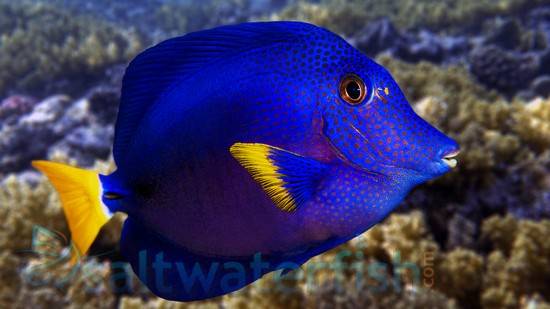The Melon Butterflyfish (Chaetodon trifasciatus) known to tropical fish keeping enthusiasts as the Indian Redfin Butterflyfish, Three-banded Coralfish, Three-banded Butterfly, Lineated butterflyfish, Pinstriped Butterflyfish, Purple Butterflyfish, Rainbow Butterflyfish, Indian Ocean Redfin Butterfly, and Red-fin Butterflyfish is only found in the Indian Ocean. Its range extends from East Africa and the islands of western and central Indian Ocean to the Andaman Sea, Cocos-Keeling Islands, Christmas Island, and western Indonesia (western Sumatra, Java, Bali ad Nusa Penida).
Chaetodon lunulatus occurs only in the Indo Pacific and ranges from East Africa to the Hawaiian and Tuamoto islands while Chaetodon trifasciatus occurs only in the Indian Ocean.
Adult Melon Butterflyfish are normally encountered singly or in pairs on the coral rich lagoons and semi protected seaward reefs of their range at depths from 6 to 98 feet, where they feed almost exclusively on coral polyps. They are especially fond of the Cauliflower Coral (Pocillopora) species.
Small juvenile Melon Butterflyfish are extremely secretive and can be found hiding among corals in shallower depths.
Melon Butterflyfish have a yellow chest and head that transitions into a pale lavender gray color towards back and tail, with darker lavender pinstripes along body. They have black lips, a vertical black band through the eye and caudal fin, and a narrower fainter band behind the eye on the gill cover. There is a dark black dash on one of the horizontal pinstripes on the upper body. The orange caudal peduncle distinguishes the Indian Ocean Redfin Butterfly (Chaetodon trifasciatus) from the Pacific Pinstripe Butterflyfish (Chaetodon lunulatus) which occurs only in the Pacific Ocean and Western Australian coast.
Although a number of publications have recorded Melon Butterflyfish (Chaetodon trifasciatus) from Australia; in the AUS EEZ, this species only occurs at the territories of Cocos (Keeling) Islands and Christmas Island in the eastern Indian Ocean.
The Melon Butterflyfish is best housed in a mature FOWLR aquarium of at least 125 gallon capacity with a crushed coralline substrate, plenty of live rock arranged into caves, crevices, and overhangs for them to hide among, and a copious amount of free swimming space.
Melon Butterflyfish are an active species that enjoy swimming. They are best housed in large, long, aquariums with other peaceful reef species or kept as pairs. Although generally peaceful, they can be territorial and aggressive to other Chaetodon.
Because Melon Butterflyfish are food specialists that feed exclusively on Pocillopora corals and nibble on tubeworms, small invertebrates and crustaceans, they are not considered reef safe.
Like most butterflyfish, Chaetodon trifasciatus are sensitive to water quality and require moderate water movement in their tank. A good filtration system with adequate skimming and a powerhead or wave maker is necessary to keep them healthy.
The Melon Butterflyfish has not been successfully bred in an aquarium environment. They are monogamous broadcast spawners that form bonded pairs that can last for life. After a courtship ritual that involves swimming in circles while rising up to the surface, the female releases her small pelagic eggs into the water column at the same time the male releases his sperm to fertilize them. The fertilized eggs hatch out into transparent larvae that float along the surface in the plankton chain until they grow to sufficient size to settle on the bottom and eventually become juveniles.
In their natural habitat, Melon Butterflyfish are obligate corallivores that feed on polyps from a wide range of different coral species, with a preference for coral polyps of the Cauliflower Coral (Pocillopora) species. They may also eat zooplankton, tubeworms, and small invertebrates.
In an aquarium environment Chaetodon trifasciatus usually starve in captivity because they rarely transition to feeding on anything but live corals. Rarely, some individuals will accept live zooplankton or live mussels with crushed shells. Another trick is to mimic their natural feeding behavior by stuffing frozen foods into coral skeletons or stones. If they still refuse to adapt to eating live or frozen Mysis shrimp, enriched brine shrimp, or cyclopes replacement foods; the only way to keep Chaetodon trifasciatus is to feed them their natural diet of live SPS or LPS corals.
The Melon Butterflyfish (Chaetodon trifasciatus) is occasionally available to tropical fish keeping enthusiasts from a variety of online retailers, wholesalers, and transhippers at the following approximate purchase sizes: Small 1.5-2″ $69.99; Medium 2-3″ $80.00.
Minimum Tank Size: 125 gallons
Aquarium Type: FOWLR
Care Level: Difficult
Temperament: Peaceful
Aquarium Hardiness: Average
Water Conditions: 70.5° – 88.5° F, dKH 8 – 12°, pH 8.1 – 8.4, sg 1.020-1.025
Max size: 6.9″
Color Form: Yellow, Lavender, Black, Orange
Diet: Corallivore
Compatibility: Not reef safe
Origin: Cocos (Keeling) Islands and Christmas Island
Family: Chaetodontidae
Lifespan: 5-8 years
Aquarist Experience Level: Expert





















































































